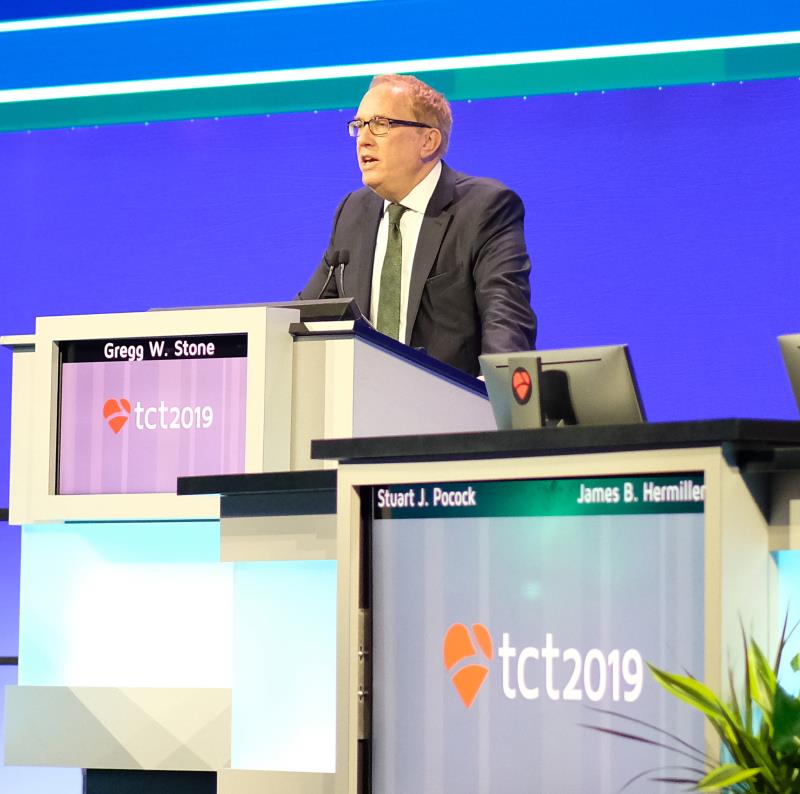 Dr Gregg Stone
Dr Gregg StoneIndividuals with left main coronary artery disease (CAD) who underwent percutaneous coronary intervention (PCI) or coronary artery bypass graft (CABG) continued to show similar rates of the primary outcome (composite of death, stroke, or myocardial infarction), highlighting the potential of PCI as a CABG alternative in this patient setting, according to the final results of the EXCEL* trial presented at TCT 2019.
At 5 years, the difference between PCI and CABG in terms of the incidence of the primary outcome was only 2.8 percentage points (22.0 percent [PCI] vs 19.2 percent [CABG]; odds ratio [OR], 1.19, 95 percent confidence interval [CI], 0.95–1.50; p=0.13). [TCT 2019, LBT3 Session 3; N Engl J Med 2019;doi:10.1056/NEJMoa1909406]
This result translates to a sustained effect over 2 years following the 3-year evaluation of the 1,905 left main CAD patients (mean age 66.0 years, 76.9 percent male) who were randomized 1:1 to receive PCI or CABG. The initial results reflected comparable efficacy between the two revascularization strategies. [N Engl J Med 2016;375:2223-2235]
The time factor
Of note was the difference in the area between the curves on restricted mean survival time analysis, pointed out lead investigator Dr Gregg Stone from the Icahn School of Medicine at Mount Sinai in New York, US. The difference in incidence favoured PCI up to about 3 years, after which, this trend shifted and substantially favoured CABG. “[Nonetheless,] this is simplistic because … if you are going to have an adverse event, you would rather have it late as opposed to early – if you were a patient.”
Piecewise hazards analysis also showed varying risks of the primary outcome at three distinct periods. From 0–30 days, fewer events occurred after PCI vs CABG (4.9 percent vs 8.0 percent; hazard ratio [HR], 0.61; p=0.008). Day 30 through 365 saw similar event rates between the two arms (4.1 percent [PCI] vs 3.8 percent [CABG]; HR, 1.07; p=0.76), which substantially diverged over time (from 1–5 years) in favour of CABG due to the increased post-procedural risk associated with PCI (15.1 percent [PCI] vs 9.7 percent [CABG]; HR, 1.61; p<0.001).
“[Hence,] consideration of the differential timing of risk is clinically relevant, since earlier exposure to adverse events has a more profound influence on the long-term burden of disease than exposure to events occurring later,” noted the researchers. “The early benefits of PCI due to reduced periprocedural risk were attenuated by the greater number of events occurring during follow-up with CABG, such that at 5 years the cumulative mean time free from adverse events was similar with both treatments,” they added.
PCI a suitable CABG alternative
The findings add value to existing literature substantiating the potential of PCI as a treatment option for select patients with left main CAD. [Am Heart J 2017;190:54-63; J Am Coll Cardiol 2017;69:2212-2241; Eur Heart J 2019;40:204-212] “[Thus, our findings suggest that] PCI may be considered an acceptable revascularization modality for [this patient subgroup], a decision which should be made after heart team discussion, taking into account each patient’s individual risk factors and preferences,” said Stone.
“[Nonetheless, as the hazard curves continued to diverge at 5 years] … 10-year or longer follow-up is required to characterize the very late safety profile of PCI and CABG as both stents and bypass grafts progressively fail over time,” said the researchers.